
Diet cola, baseball, and a bounty of person-to-person interactions:
Reflections on eight and a half years as dean
by Dean Thomas L. Magnanti, Vol. 4, No. 4, July 2007
"
These years as dean of . . . 'the best engineering school in the galaxy' have been exceedingly rewarding, fun, and invigorating."
Appreciation for the opportunities, the people
As I conclude my last days as dean of MIT’s School of Engineering, people have been asking me to share the high points, challenges, and other reminiscences with them. To say the very least, these eight and a half years have been active and exciting! The list of the School’s accomplishments runs long, as you know from reading our e-newsletters, and I’m delighted to recap some of them again below. I am often asked for a personal note as well. I admit that I’ve drunk a lot of diet cola sitting through an incalculable number of meetings! (But if you want to know how baseball fits in, you’ll have to read to the end.) Seriously, though, these years as dean of what I have often referred to as “the best engineering school in the galaxy” have been exceedingly rewarding, fun, and invigorating.
Considering in retrospect all the high points of new programs, initiatives, partnerships, transformations, and other strides made—all of which are extremely gratifying—and seeing that the School is still as vibrant as ever, is for me the most enjoyable aspect of my term as dean. That and the contacts and relationships with so many marvelous people stand out in a special way. Bottom line: it’s been a tremendous privilege to have been able to interact with such wonderful faculty, students, staff, alumni, and friends; to represent the School of Engineering in a variety of quarters; and to participate in the national dialogue on important issues on behalf of the School and MIT. The person-to-person dealings have counted the most—the social interactions, the networking, the collaborations—these have been among the most satisfying occurrences in my tenure as dean.
The School has been innovating along many dimensions over the years I’ve served as dean, just as it has throughout its history and undoubtedly will do long into its future. The many achievements of our departments, laboratories, centers, and programs are far too numerous to mention here, but as a brief summary of some (mostly School-based) initiatives, let me point to the following (with due apologies for what likely are many oversights).
Renewal of the School’s faculty
I believe that the most important thing a dean can do is to ensure the vitality of the faculty: support them in their efforts and activities and, through them, support the students as well. Renewal is very important for the School and I am pleased to say that we’ve hired some spectacular young faculty. [For a small sampling, see http://web.mit.edu/engineering/enews/vol3no3.html.] When I look back on the promotions and the faculty we’ve hired in the past eight and a half years, I can’t help but do so with enormous pride. It’s also rather striking to note that we’ve hired nearly 30 percent of our faculty in these years: more than 120 new faculty members, including 34 women and 9 underrepresented minority faculty. I’m particularly proud that we have hired so many women and that we’ve changed the face of MIT and the School in a significant way by doing that.
Educational innovation
Through the iCampus project (an alliance between Microsoft Research and MIT), the d’Arbeloff Fund for Excellence in Education, School-based funding, and many departmental initiatives, we made significant investments in educational innovation, including new pedagogical approaches and content areas. Several of our departments made wholesale changes to their undergraduate curricula, and many of them developed more hands-on learning and laboratory-based instruction. We introduced eleven new graduate and undergraduate degree programs.
We created the new Undergraduate Practice Opportunities Program which serves 36 percent of the sophomore engineering class and the departments; UPOP has been enormously successful. I anticipate that ten years from now, we will hear some wonderful stories about what a difference UPOP has made in the lives of some of our graduates. Many of our current students have told me that, in terms of their educational experiences at MIT, UPOP influenced them as much as anything at MIT.
As outreach efforts to younger students, particularly those in traditionally underserved segments of the population, we have developed middle school (SEED) and elementary school (STEM) versions of MITES as well as the Women's Technology Program (with separate curriculum tracks in Electrical Engineering and Computer Science and in Mechanical Engineering). This summer, our Office of Engineering Outreach Programs is launching a new program, the MIT Science of Baseball, a four-week program aimed at improving the mathematics and science skills of entering eighth grade boys from Boston and Cambridge by building on their interest in baseball to learn physics and math. The School is currently developing an outreach site that centers on a selection of YouTube-like videos on engineering and science, geared to a younger audience and supported by social networking tools.
For adults, we enhanced our educational outreach by creating the Professional Educational Program, making our professional education offerings more vibrant than ever. PEP offers short courses, one-week programs, and even some new initiatives. For example, jointly with the Sloan School, we established a large-scale program for British Petroleum, and we launched a program last year for mid-career professionals returning to MIT.
New vectors of research
In the years that I’ve served as dean, the School has developed many new vectors of research, including numerous developments in what I dubbed the “Big Four Os” of bio-, nano-, info-, and macro- engineering. Who would have imagined ten or fifteen years ago . . .
- that we’d be talking about something called nanotechnology today?
- that we’d be talking about bioengineering in quite the way we discuss it today, in spite of early roots of these activities at MIT going back to the ’50s and ’60s?
- that we’d see such of an explosion of the information revolution and its impact on everything that we do in engineering?
- and that we would advance our understanding and program offerings in the “macro” as well, examining large-scale technical systems?
A significant portion of the outstanding research our faculty conducts today lies in much the same areas as ten years ago, and I’d expect that to continue into the next ten years as well. However, when we reflect upon these “Big Four O” areas of research emphasis, we can’t help but notice a very dramatic change, one we should recognize as we consider the future.
Industrial and international partnerships
Over these past years, we’ve created a number of industrial and international partnerships. We’ve established some long-standing industrial partnerships with several companies including Hewlett Packard, Microsoft, Dupont, Nokia, NEC, and Ford. These partnerships have provided wonderful opportunities for us to bring the fruits of our research closer to practice and afforded valuable opportunities for our faculty and our students to collaborate with outstanding people in industry.
Internationally, we initiated some very successful programs that began at about the time I became dean: the Singapore-MIT Alliance, and, a little later, the Cambridge-MIT Institute. Recently, we started two large-scale international programs: one in Portugal and the other in Abu Dhabi. Like our industrial partnerships, our international programs offer unique opportunities and valuable support to our faculty and students. In addition and as importantly, they provide the chance to work on issues that are of particular importance to our international partners and to the world. At this time, we are on our way to consummating another significant, large-scale relationship with Singapore: the new SMART Center, MIT’s first research facility outside the United States. It’s a very exciting initiative and it has been wonderful to watch it develop.
Entrepreneurship and invention
We’ve placed renewed emphasis on technological innovation and invention with programs like the Deshpande Center for Technological Innovation and the Lemelson-MIT program, and continued to support many of the important ongoing activities of our student population. We consider the Deshpande Center one of our signature activities in the next generation of technologies; it’s off to a spectacular success, funding some very exciting research projects and spinning out some of those projects to commercialization.
We’ve seen more emphasis on entrepreneurship throughout the School, and we see its manifestations in many ways:
- the MIT $50K Entrepreneurship Competition has grown to become the MIT $100K Entrepreneurship Competition and has been working very effectively with us in the School;
- we’ve started a large number of entrepreneurship-based activities; and
- we’ve witnessed the continuing success and expansion of the Lemelson-MIT Program as one of those activities, including its outreach efforts.
Improvements to the physical environment
We have made many investments in the physical environment in the time that I have served as dean. These include some sparkling new department- and center-based teaching and research laboratories, new classrooms, and the opening of the Stata Center. These spaces will serve us well for the future. Since I anticipate that I myself will soon be moving to the Stata Center, I like to think that the opening of that unusual structure has certainly provided a signature creation in the physical landscape of MIT. As importantly, it enabled us to bring computer science back onto our campus; to provide space for Computer Science and Artificial Intelligence, the Laboratory for Information and Decision Systems, and Linguistics; and to provide a vibrant, new venue for our faculty and students to collaborate more flexibly together. All our spaces not only help us improve and expand the physical infrastructure that permits us to do more things better, they also buoy our spirits.
Organizational changes in the School
During my term, we have seen the continuing evolution of our Engineering Systems and Biological Engineering divisions, with the latter even becoming the School's first new department in nearly 50 years [*] at the beginning of this month; the merger of Mechanical and Ocean Engineering, of the merger of two of our largest laboratories into Computer Science and Artificial Intelligence Laboratory (CSAIL); and the development of a more flexible organizational structure with our dual faculty appointments. At this time, 45 of our faculty hold dual appointments; in effect, each holds an allegiance to two academic as units, and often to multiple laboratories and centers as well. It's been gratifying to see these considerable changes, which position us well for the future.
Expanded communications
Through this bimonthly electronic newsletter, an enhanced School website, and other venues, we’ve endeavored to communicate more effectively with our alumni and friends, as well as with our colleagues on campus. Doing our best to keep all concerned abreast of the exciting, new things going on here has met with a very positive response. This spring, the School also sponsored the creation of MIT TechTV, a beta site for the MIT community to upload and share videos, an undertaking that I hope will also help communicate the depth and breadth of this very special place.
Next steps
When people ask a faculty member, “What’s most gratifying about being a professor?” the usual answer is to point to our extraordinary students, particularly watching them flourish in their careers as they leave the “nest” and go on to accomplish other things. In much the same way, as dean I’ve had the privilege of witnessing the accomplishments of our faculty, staff and students and the enormous satisfaction of knowing that the School continues to become stronger and stronger. Having had the opportunity to serve as dean of the School of Engineering has been a particular pleasure, indeed, an honor and a privilege. I am deeply appreciative for all that our faculty, staff, students, the MIT senior administration, and our loyal alumni/ae have done to make the past eight and a half years so enjoyable and productive.
Going forward, I know that the School will benefit from the fresh perspective that the new dean, Subra Suresh, will bring, and I look forward to working with him to ensure a smooth transition. While I am eager to refocus on research and education, including the completion of a couple of books, I am also glad to have had this opportunity to share these reminiscences.
Last but not least . . . baseball!
Shortly before I step down, I will enjoy a final, and perhaps unusual, side benefit of serving as dean of MIT’s School of Engineering. In an historic moment in my family’s life as avid fans, I will be throwing out the ceremonial first pitch at a Red Sox game! While this perhaps doesn’t rank among the most significant accomplishments in my term as dean, I could argue it will certainly rate as a peak experience in my life. It would certainly challenge me to imagine anything better than being a dean or a professor at MIT. But if anything in my life could have topped that, it would have been to follow in the footsteps of greats Ted Williams, Carl Yastrzemski, Jim Rice, and Manny Ramirez and be the left fielder for the Red Sox.
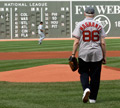
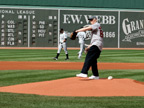
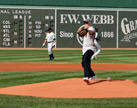
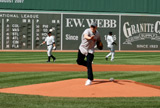
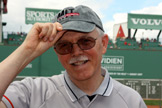
Photos on the mound by Tim Zue; closeup by Lawrence Gallagher.
[*] The Department of Nuclear Engineering was established in 1958 and in 2004 changed its name to the Department of Nuclear Science and Engineering.





